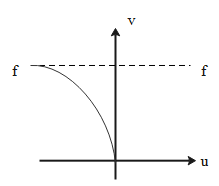
The graph between u and v for the convex mirror is
A.

B.

C.

D.





Answer
520.5k+ views
Hint: We will define the terms used in the graphs given, as the graph depends on these parameters. Taking into consideration the convex mirror, we will find the
relation between these terms and the distance at which the image gets formed.
Complete answer:
The terms used are: “u”, “v” and “f”.
“u” – The distance between the object and the pole of the mirror is called the object distance.
“v” – The distance between the image formed and the pole of the mirror is called the image distance.
“f” – The distance between the principal focus and the pole of the mirror is called the focal length or the focus.
We will trace out the graph by changing the positions of the object.
The object will be placed on the left side of the mirror. So, the position of the object will be considered to be negative, whereas, the image gets formed on the right side of the mirror, so, the position of the image will be considered to be positive.
Let the object be placed at infinity, that is, \[(-\infty )\], the parallel rays hit the mirror and the image gets formed at the focus. The distance between the parallel plane and the rays passing through the mirror decreases as the position of the object with respect to the mirror decreases. Finally, when the object distance tends to zero, the image distance also tends to zero.
This nature of the graph is defined by the graph of (A).
\[\therefore \] As the graph (A) defines the graph between u and v for the convex mirror.
Thus, option (A) is correct.
Note:
The position of the formation of the image per change in the position of the object placed in front of the mirror gives the curve for the graph of u versus v. As we keep on tracing the formation of the image, we will get the required graph, even in the case of a concave mirror.
relation between these terms and the distance at which the image gets formed.
Complete answer:
The terms used are: “u”, “v” and “f”.
“u” – The distance between the object and the pole of the mirror is called the object distance.
“v” – The distance between the image formed and the pole of the mirror is called the image distance.
“f” – The distance between the principal focus and the pole of the mirror is called the focal length or the focus.
We will trace out the graph by changing the positions of the object.
The object will be placed on the left side of the mirror. So, the position of the object will be considered to be negative, whereas, the image gets formed on the right side of the mirror, so, the position of the image will be considered to be positive.
Let the object be placed at infinity, that is, \[(-\infty )\], the parallel rays hit the mirror and the image gets formed at the focus. The distance between the parallel plane and the rays passing through the mirror decreases as the position of the object with respect to the mirror decreases. Finally, when the object distance tends to zero, the image distance also tends to zero.
This nature of the graph is defined by the graph of (A).
\[\therefore \] As the graph (A) defines the graph between u and v for the convex mirror.
Thus, option (A) is correct.
Note:
The position of the formation of the image per change in the position of the object placed in front of the mirror gives the curve for the graph of u versus v. As we keep on tracing the formation of the image, we will get the required graph, even in the case of a concave mirror.
Recently Updated Pages
Master Class 12 Business Studies: Engaging Questions & Answers for Success

Master Class 12 Economics: Engaging Questions & Answers for Success

Master Class 12 English: Engaging Questions & Answers for Success

Master Class 12 Maths: Engaging Questions & Answers for Success

Master Class 12 Social Science: Engaging Questions & Answers for Success

Master Class 12 Chemistry: Engaging Questions & Answers for Success

Trending doubts
What are the major means of transport Explain each class 12 social science CBSE

Which are the Top 10 Largest Countries of the World?

Draw a labelled sketch of the human eye class 12 physics CBSE

How much time does it take to bleed after eating p class 12 biology CBSE

Explain sex determination in humans with line diag class 12 biology CBSE

Differentiate between homogeneous and heterogeneous class 12 chemistry CBSE




